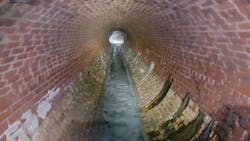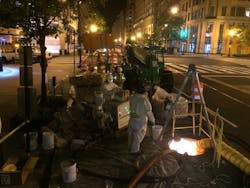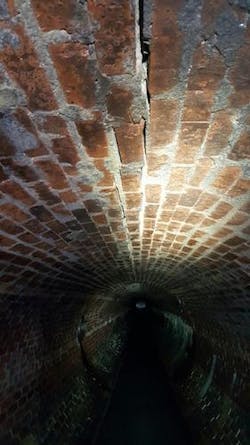About the author:
Joe Royer, PhD, is development manager for Milliken Infrastructure Solutions. Royer can be reached at [email protected] or 855.655.6750.
The Washington, D.C., sewer system is managed by DC Water. Its system includes many large diameter brick structures that took decades to complete. As the pipes age, they are in need of repair. DC Water’s engineering group implemented a pipe entry inspection after receiving an alert from the District Department of Transportation (DDOT) to verify the integrity of a 72-in.-diameter brick sewer located at the F Street NW block between 11th and 12th Streets. The DDOT had done a bore-hole inspection at a street depression which revealed a 20-in. deep void under the pavement.
Inspecting the Damage
Prior to entering the sewer, DC Water evaluated its records and noted that the Metro subway tunnel runs below the length of 12th Street and the 72-in. brick sewer runs above the tunnel. In the 1970s, a 188-ft section of the sewer was offset and replaced with 205 ft of 72-in. reinforced concrete pipe (RCP) to make room for the construction of the Metro Subway’s air conditioning piping at 12th and F Streets. The entry inspection showed the replaced 72-in. RCP was in great shape, but starting at the interface with the RCP, the brick crown was cracked and propagating east toward 11th Street and west toward 13th Street. This crack likely developed after the construction of the Metro Subway system.
The most severe damage was located between 11th and 12th Streets, where the 12 o’clock crown was cracked and missing bricks. Additionally, the mortar behind the missing bricks was fractured. Fortunately, there was no significant oval deformation, and there were not many open mortar joints, which would be typical of an impending pre-sink-hole collapse scenario.
Further inspection revealed two illegal abandoned taps that were nearly filled with soil. One of the taps was within 3 ft of the void below the pavement. In addition to soil loss at these taps, the Metro Subway’s air conditioning return piping was suspected to be leaking and causing mud to form in the area. Therefore, the wet soil combined with the Metro Subway vibrations caused additional soil consolidation and settlement. Fortunately, the city’s roads primarily are 10 in. of reinforced concrete, so this bridged much of the 20-in. void and there was only a slight surface depression.
DC Water engineers recommended grouting the illegal taps, fixing the air conditioning pipes and structurally lining the worst of the fractured brick sewer between 11th and 12th Streets. The company considered use of cured-in-place-pipe (CIPP), slip-lining, tunnel plate steel, calcium aluminate and geopolymer.
Ensuring Reliability
In the fall of 2015, Inland Pipe Rehabilitation LLC (IPR) provided construction services as a subcontractor to Anchor Construction, the general contractor on the project, to install Milliken’s GeoSpray geopolymer mortar material as a corrosion resistant, structural pipe rehabilitation solution for the sewer. It was applied centrifugally using IPR’s patented EcoCast installation method.
To ensure DC Water received a quality rehabilitated asset, IPR’s general process included the following:
• Pre-Inspection and CCTV, cleaning, stopping infiltration and surface preparation. After an initial CCTV inspection, a minimum 3,500 psi pressure wash was used to clean the host pipe of loose debris and material. Joint leakage and infiltration were treated with hydrophobic grout, and missing bricks or irregular shapes were filled in to establish a rounded template. The surface did not need to be dry prior to application of the geopolymer because a damp surface is preferred for casting.
• Centrifugal Casting. 50-lb bags of dry geopolymer material were blended with a maximum of a 0.2 ratio by mass of water to material at the mixer. IPR’s patented EcoCast centrifugal casting process has a spinning head that distributes the geopolymer mortar onto the pipe walls. Quality assurance compression and flexural tests were tested by a certified third-party laboratory.
• Post-Inspection & CCTV. IPR provided DC Water a detailed quality assurance and quality control report with the pre- and post-CCTV inspections, quality assurance material testing, daily material usage and crew logs.
Overcoming & Addressing Operational Challenges
IPR worked with DC Water to acquire detailed project maps, traffic control and sewer flow volume information, which provided a baseline of challenging issues for which to plan and account. Dry weather daytime volume was found to be a continuous flow and traffic was congested. After talks with multiple parties, including DC Water, Anchor Construction, IPR, local residents, and business owners, it was decided that night construction would minimize car and pedestrian traffic impacts and increase worker safety.
F Street has a parking lane on both sides and two lanes of traffic in both directions. The manhole access was in the center of the right traffic lane, therefore, the parking and right travel lane needed to be closed for construction.
The nighttime working hours were set between 7 p.m. and 5 a.m., Monday through Friday. The typical installation footprint needs to accommodate a 26-ft box rig with the back gate down, and the mixer near the manhole with a tripod set up, staged pallets of mortar, and a telehandler to move the pallets. The wider two-lane area provided a wider construction safety area. External bypass was simple to set up because it was along the curb line and did not have to cross streets.
Anchor Construction provided all traffic control for the project. Each evening, material and equipment were mobilized at 7 p.m., safety measures and bypass were set up and the pipe was pressure-washed with 3,500 psi of water. A benefit of using a geopolymer mortar is that flow can be returned after about a two-hour cure. IPR would finish spraying before 3 a.m. so the crew could demobilize and return flow by 5 a.m.
Prior to any lining, all loose scaling materials and slime layers were removed. Cleaning exposes problem areas such as crack voids and active infiltration in which to grout. Depth gauge markers were installed throughout the sewer to assist with confirming liner thickness. Concrete screws were used and set to a depth of 2.25-in. as this would accommodate the head being covered with a 2.5-in. lining.
Since the overall design included wire mesh on the crown, approximately 1.5-in. of geopolymer was applied and allowed to cure overnight before the wire mesh was installed. Most construction projects do not require wire mesh in their design, but due to the cracking and missing bricks in the crown, DC Water requested wire mesh as an added safety measure and IPR applied an additional 1-in. geopolymer layer on top of the mesh.
When the project was completed, DC Water, Anchor Construction and IPR reflected on five challenges and lessons learned.
First, there currently is no nationally accepted ASTM design standard for spray-on cementitious liner materials such as GeoSpray geopolymer. ASTM F-1216 is used for designing CIPP, but there needs to be a similar national standard for spray-on cementitious liners to fairly compare equivalent load-bearing capacity designs for different materials. For example, the construction documents could set a minimum design thickness of 2-in., but the contractor also may provide a thickness design.
For a contractor to be competitive, costs need to remain low by developing a design that falls at or below the required 2-in. minimum. Leaving a design up to interpretation means potentially using a weaker material with a less conservative design method or a stronger material with a conservative design. In both scenarios, there is potential to round up to the specified 2-in. minimum. The owner will be presented with two professional engineer stamped 2-in. design options that will not have apples-to-apples load bearing capacity.
Second was design liability because finite element (FEM) liner design is not an exact science and using it can pose a challenge for consultants. In addition, consultants may not want to do a liner design due to potential liability. However, leaving the design open to interpretation by others may not be the best way to protect a municipal client’s interest to receive the best possible product options. Fortunately for this project, DC Water had in-house staff competent in FEM analysis to set minimum design thicknesses and realistic guidelines on acceptable material strength properties.
Thirdly, the nightly mobilization and demobilization of equipment, material, traffic control and safety measures are expensive and decrease the overall working window for spraying operations. Future nighttime construction should be evaluated by considering the potential to leave the construction equipment and barricades in place during the day so evening construction spraying operations could start sooner and cut down the total number of required construction days.
Fourth, IPR, DC Water and Anchor Construction found that geopolymer installation procedures are more resilient in hot, cold and wet weather compared to other rehabilitation options. DC Water has added geopolymer to its liner selection option for use in seasonal cold or wet weather
emergency repairs.
And finally, considering the future of subway construction was critical. There are several brick masonry fractures near other Metro Subway tunnels, so this could be a common vibration symptom. If any future subways are constructed near brick sewers, it is recommended that the brick be replaced with RCP for a full block on each side of the tunnel.


